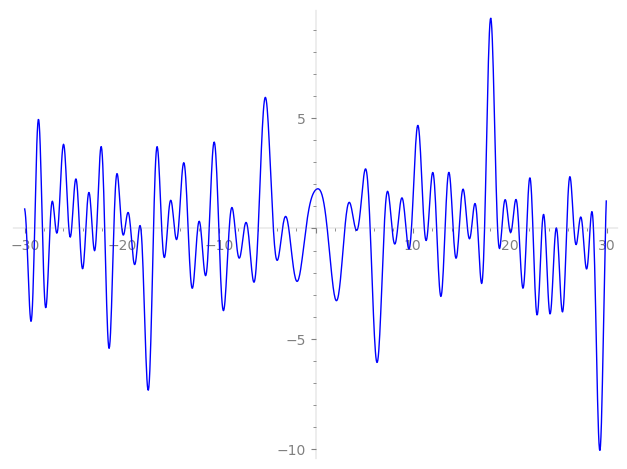| L(s) = 1 | + (1.31 − 1.12i)3-s + (−3.06 + 1.77i)5-s + 0.587i·7-s + (0.471 − 2.96i)9-s + 3.00·11-s + (0.973 − 1.68i)13-s + (−2.05 + 5.78i)15-s + (1.36 − 0.790i)17-s + (4.34 − 0.308i)19-s + (0.660 + 0.773i)21-s + (1.35 − 2.34i)23-s + (3.77 − 6.53i)25-s + (−2.71 − 4.43i)27-s + (4.59 + 2.65i)29-s + 4.43i·31-s + ⋯ |
| L(s) = 1 | + (0.760 − 0.649i)3-s + (−1.37 + 0.792i)5-s + 0.221i·7-s + (0.157 − 0.987i)9-s + 0.907·11-s + (0.270 − 0.467i)13-s + (−0.529 + 1.49i)15-s + (0.332 − 0.191i)17-s + (0.997 − 0.0708i)19-s + (0.144 + 0.168i)21-s + (0.282 − 0.489i)23-s + (0.755 − 1.30i)25-s + (−0.521 − 0.853i)27-s + (0.853 + 0.492i)29-s + 0.796i·31-s + ⋯ |
\[\begin{aligned}\Lambda(s)=\mathstrut & 912 ^{s/2} \, \Gamma_{\C}(s) \, L(s)\cr =\mathstrut & (0.885 + 0.464i)\, \overline{\Lambda}(2-s) \end{aligned}\]
\[\begin{aligned}\Lambda(s)=\mathstrut & 912 ^{s/2} \, \Gamma_{\C}(s+1/2) \, L(s)\cr =\mathstrut & (0.885 + 0.464i)\, \overline{\Lambda}(1-s) \end{aligned}\]
Particular Values
| \(L(1)\) |
\(\approx\) |
\(1.69567 - 0.417327i\) |
| \(L(\frac12)\) |
\(\approx\) |
\(1.69567 - 0.417327i\) |
| \(L(\frac{3}{2})\) |
|
not available |
| \(L(1)\) |
|
not available |
\(L(s) = \displaystyle \prod_{p} F_p(p^{-s})^{-1} \)
| $p$ | $F_p(T)$ |
|---|
| bad | 2 | \( 1 \) |
| 3 | \( 1 + (-1.31 + 1.12i)T \) |
| 19 | \( 1 + (-4.34 + 0.308i)T \) |
| good | 5 | \( 1 + (3.06 - 1.77i)T + (2.5 - 4.33i)T^{2} \) |
| 7 | \( 1 - 0.587iT - 7T^{2} \) |
| 11 | \( 1 - 3.00T + 11T^{2} \) |
| 13 | \( 1 + (-0.973 + 1.68i)T + (-6.5 - 11.2i)T^{2} \) |
| 17 | \( 1 + (-1.36 + 0.790i)T + (8.5 - 14.7i)T^{2} \) |
| 23 | \( 1 + (-1.35 + 2.34i)T + (-11.5 - 19.9i)T^{2} \) |
| 29 | \( 1 + (-4.59 - 2.65i)T + (14.5 + 25.1i)T^{2} \) |
| 31 | \( 1 - 4.43iT - 31T^{2} \) |
| 37 | \( 1 - 6.60T + 37T^{2} \) |
| 41 | \( 1 + (-7.82 + 4.51i)T + (20.5 - 35.5i)T^{2} \) |
| 43 | \( 1 + (5.77 - 3.33i)T + (21.5 - 37.2i)T^{2} \) |
| 47 | \( 1 + (-3.48 + 6.04i)T + (-23.5 - 40.7i)T^{2} \) |
| 53 | \( 1 + (3.87 + 2.23i)T + (26.5 + 45.8i)T^{2} \) |
| 59 | \( 1 + (-7.23 - 12.5i)T + (-29.5 + 51.0i)T^{2} \) |
| 61 | \( 1 + (0.0261 - 0.0452i)T + (-30.5 - 52.8i)T^{2} \) |
| 67 | \( 1 + (0.662 + 0.382i)T + (33.5 + 58.0i)T^{2} \) |
| 71 | \( 1 + (5.86 + 10.1i)T + (-35.5 + 61.4i)T^{2} \) |
| 73 | \( 1 + (4.10 + 7.10i)T + (-36.5 + 63.2i)T^{2} \) |
| 79 | \( 1 + (7.80 - 4.50i)T + (39.5 - 68.4i)T^{2} \) |
| 83 | \( 1 + 13.6T + 83T^{2} \) |
| 89 | \( 1 + (9.20 + 5.31i)T + (44.5 + 77.0i)T^{2} \) |
| 97 | \( 1 + (5.27 + 9.13i)T + (-48.5 + 84.0i)T^{2} \) |
| show more | |
| show less | |
\(L(s) = \displaystyle\prod_p \ \prod_{j=1}^{2} (1 - \alpha_{j,p}\, p^{-s})^{-1}\)
Imaginary part of the first few zeros on the critical line
−9.990613758738212446338106351722, −8.917827103513847728378846176220, −8.317693355677426318457959721714, −7.36872481784549452099231753110, −7.00346044117859006001204140141, −5.92682853883609310289357571035, −4.36793153072100974032309170164, −3.42416047229390167872875671691, −2.78109900268435253693710864549, −1.00894037986248744848214684119,
1.18281344999037677388623218280, 2.99966104189212395534506991117, 4.09053053442677311303229639480, 4.33883070699590262176308676651, 5.61067564296385165178988144024, 7.05350095553343740883092657952, 7.86616638955114281850653325905, 8.440744526216227980311100600317, 9.303643233889309191022667336332, 9.868640395339997435044738724249

